Wed 29 Jun 2011
Mike Nevins on DASHIELL HAMMETT, ERLE STANLEY GARDNER & BERNARD HERRMAN.
Posted by Steve under Authors , Columns , Pulp Fiction[10] Comments
by Francis M. Nevins
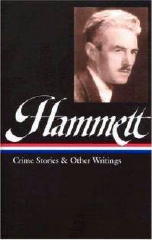
If you own a copy of the Library of America’s Dashiell Hammett volume Crime Stories & Other Writings (2001) and also a copy of Ellery Queen’s Mystery Magazine for July 1945, then, whether you know it or not, you have two different versions of Hammett’s Continental Op story “The Tenth Clew†(Black Mask, January 1, 1924).
The first difference between the two leaps out: the last word of the title is spelled “Clew†in both Black Mask and the Library of America collection but Fred Dannay changed it to the more common “Clue†when he reprinted the tale in EQMM.
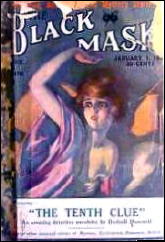
To appreciate the final difference between the two requires a little knowledge about the story’s plot. Leopold Gantvoort, a 57-year-old widower whose net worth is around $1,500,000, is planning to marry a much younger woman, but he’s murdered before the marriage takes place and also before he’s signed a new will leaving half his fortune to her.
The Op exposes her as a confidence woman and the murderer as her scam partner, who’s been posing as her brother. Here are the last few sentences as Hammett wrote them.
What’s wrong here? Since Gantvoort was killed before either changing his will or marrying the woman, there’s no way on earth she could have inherited half his estate! Fred Dannay obviously caught this flub, and spared Hammett some potential embarrassment by taking it upon himself to rewrite those lines.
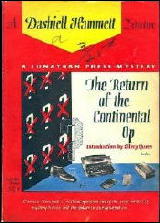
Very shortly after this story appeared in EQMM, Fred included it in the digest-sized paperback original collection The Return of the Continental Op (Jonathan Press pb #J 17), which was published in the first week of July 1945, a month or two before Hammett came back to the U.S. from Army service in the Aleutian Islands during World War II.
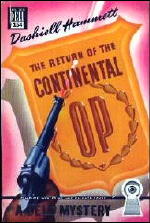
If any reader of this column has a copy of that edition, which I don’t, I’d love to know whether the text of this story is Hammett’s original or Fred’s revision. (My hunch is the latter.)
Settled back into civilian life, Hammett started teaching an evening course on mystery writing at the Jefferson School of Social Science, a Communist-affiliated institution on New York’s Sixth Avenue, and Fred joined him regularly as unofficial co-instructor.
When Return was reprinted in ordinary paperback format (Dell pb #154, 1947), the last paragraph of the story was unaccountably back in its original form. Had Hammett objected to Fred’s bold attempt to spare him a few blushes?
Erle Stanley Gardner’s pulp stories of the early 1930s, and his early novels as well, were hugely influenced by Hammett although in later years he resented having the fact pointed out.
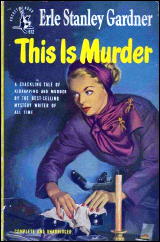
In Chapter 20 of one of those early novels, the non-series whodunit This Is Murder (1935, as by Charles J. Kenny), a suspect has just been exposed as an ex-con. “Where was your first conviction?†he’s asked. “In Wisconsin.†“You served a term there?†“Yes, sir, at Waupum.â€
In fact the name of the town is Waupun, which locals unaccountably pronounce Wau-PAN. According to Wikipedia the place was supposed to have been named Waubun, which is a Native American word meaning dawn of day, but some state bureaucrat misspelled it and the mistake has never been corrected.
The town’s chief industry is prisons — three of them! — but it’s also known for having more outdoor sculpture per capita than any other city in North America. The most famous such piece in Waupun is the “End of the Trail†sculpture: a young warrior on his horse contemplates the end of life as his people had known it.
I saw it when I passed through the town years ago. The Library Bar on Waupun’s Main Street served the finest fries I’ve ever eaten. My buddy Joe Google tells me it’s no longer there. Drat!
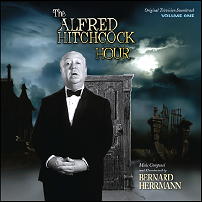
I am finishing this column on June 27, two days short of what would have been the 100th birthday of my favorite American composer. The centenary of Bernard Herrmann (1911-1975), who’s best known for having scored films like Citizen Kane, Vertigo and Psycho, is being celebrated throughout the music world, and Varese Sarabande Records has just made a huge contribution to the festivities by releasing The Alfred Hitchcock Hour, Volume One.
Herrmann wrote original scores for 17 Hitchcock Hour episodes during the program’s second and third seasons (1962-64), and this handsome two-CD set contains eight of them, more than two and a half hours of primo Herrmann never before available in audio form. Volume Two, let’s hope, will bring together the other nine — and soon. As I wrote in an earlier column, no one does ominous like Herrmann does ominous.
June 29th, 2011 at 3:06 pm
It’s “Clue” on the BLACK MASK cover, but “Clew” inside!
June 29th, 2011 at 3:20 pm
That’s something I find so odd in Golden Age detective fiction from the 1920s and into the 1930s. Clue is spelled “clue” in Britain but “clew” in the US. For some reason, what I always thought of as the archaic form of the word was preferred in American mystery (was this true in other writing as well).
June 29th, 2011 at 3:23 pm
By the way, an edition of Hammett’s non-fiction crime writing is supposed to be out in July. I really hope this includes all his crime fiction reviews. For eighty years now people have been satisfied merely with citing his bashing of The Benson Murder Case, but he did a lot more reviewing than that!
June 29th, 2011 at 3:34 pm
I have always believed Dannay’s greatest contribution to mystery fiction was not Ellery Queen but his part in keeping the short story mystery format alive.
However, the thought of him rewriting a single word of any author’s work without the author’s approval is wrong (but not that unusual either). But considering Hammett’s apparent low regard for his own work, I doubt Hammett cared.
June 29th, 2011 at 6:03 pm
Amazon.com has THE CRIME WAVE: Collected Non-fiction by Hammett for sale for only $20.00. It’s due out in July and looks like a must have book for all lovers of mystery fiction.
June 29th, 2011 at 6:11 pm
Yes, Walker, I think Hammett’s reviews are a valuable resource (not to mention other writing that might be in there). I’ve got all of them from the Saturday Review and they paint a really interesting picture of what he thought about the detective novel. It’s really surprising to me that they’ve never been collected. People may not know all the books he reviews, but, still, it is Hammett!
June 29th, 2011 at 9:06 pm
I pulled out my copy of the Jonathan Press edition of Return of the Continental Op and was surprised to see that Hammett’s original ending appears in that edition as well. I had always assumed that the Mercury Press collections contained Dannay’s “retouched” texts, and had made a note to that effect in my Digest Index. Obviously these books need a second look.
June 30th, 2011 at 10:26 am
Fascinating comments! So my hunch was wrong, and the Dannay version of the ending was dropped before Hammett got out of the military. Might this mean that Lillian Hellman made him put back the original?
It might also mean simply that Fred had second thoughts about the propriety of rewriting Hammett, but since over the years he continued to tinker with the texts of other stories he reprinted, including authors of the stature of Woolrich, I don’t think this is the answer.
August 6th, 2011 at 4:40 pm
Interesting post. I’ve been doing something similar over on Don Herron’s Hammett website http://www.donherron.com/
So far, I’ve compared the texts of about a half dozen Hammett stories as they appeared in the Dannay-edited digests against their original magazine appearances. The changes range from none to considerable.
In the post that Don put up today, I discuss the possibility that not all of the edits came from Dannay. Some seem to derive from their reprinting in various newspapers by King Features Syndicate in the 1930s. I also speculate as to whether Hammett was involved in any of these reprints.
March 4th, 2021 at 10:53 am
Are you sure Hammett was wrong? The story says the will was drafted, giving half to the woman, by the man with his lawyer, but he was killed by another man before he could sign. His intent, witnessed by his lawyer, was that she get half. Her intent was to marry him, and she fully cooperated with police to put all the blame on the killer. Under those conditions, a probate court would probably accept the unsigned will, since it represents the dead man’s will. Also, the Continental Op would not object, since he also wanted the killer hanged, since the killer also tried to kill him.